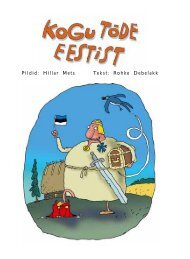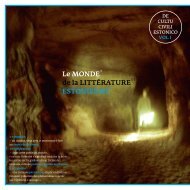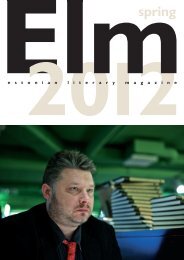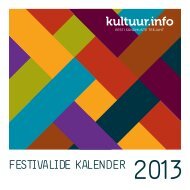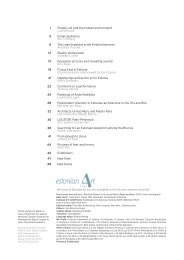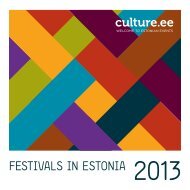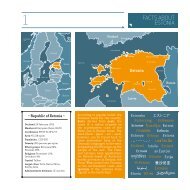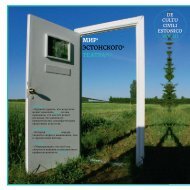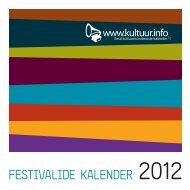Autumn 2013
Autumn 2013
Autumn 2013
You also want an ePaper? Increase the reach of your titles
YUMPU automatically turns print PDFs into web optimized ePapers that Google loves.
dictionaries as well as friends who can help<br />
resolve any uncertainties. It is much more<br />
important to be highly proficient in the<br />
language of translation because at least<br />
three quarters of a translator’s work relate to<br />
the final text: it must be elegant and<br />
apparently unlaboured, free from any traces<br />
of the original language, be this in the syntax<br />
or the idioms; ways of matching the different<br />
language levels employed in the original text<br />
must be found; metaphors and word plays<br />
must somehow be dealt with.<br />
Translating from Spanish is a much more<br />
competitive field and the huge majority of<br />
interesting books have already been<br />
translated, often from their initial publication.<br />
Spanish is very similar to French, so it has<br />
no mystery for me. In contrast, many<br />
Estonian expressions do not have a French<br />
equivalent and certain words (such as kõle)<br />
are frankly untranslatable. Such factors<br />
present a real challenge that makes<br />
translating from Estonian much more<br />
interesting intellectually. Lastly and paradoxically,<br />
in view of what has just been said,<br />
and the close similarity of Spanish and<br />
French, it may be more difficult to translate<br />
from Spanish than from Estonian; in a<br />
Spanish phrase half the words might well be<br />
identical to French words. As a result, it is<br />
very difficult to eliminate the influence of the<br />
original text, whilst finding a precisely<br />
equivalent word, expression or grammatical<br />
construction in French which does not<br />
misinterpret the original text. Translating<br />
from Estonian requires one to distance<br />
oneself much more from the linguistic<br />
structure of the original text; this provides<br />
more freedom for the translator.<br />
So here I am: a translator. It provides a<br />
pleasant change from by day job as a<br />
teacher, helps me keep fit intellectually, and<br />
holds Alzheimer’s at bay. Other than two<br />
historical articles and contributions to<br />
collective works, L’homme qui savait la<br />
langue des serpents, is my third published<br />
work, following the third part of “Truth and<br />
Justice” by Tammsaare and an anthology by<br />
Tuglas Shadow of a Man. But why did I<br />
choose this novel? Most of all because I<br />
enjoyed it so much when I read it in Estonian,<br />
but also because translating it provided<br />
me with the ideal pretext for reading it again<br />
(in fact, I have reread it seven times, from<br />
start to finish). But I had no clear plan for its<br />
publication; I took the risk that my translation<br />
might end up in the same filing cabinet as<br />
that which holds the Ristikivi work; of course,<br />
one can only allow such behaviour when<br />
there is a regular salary coming in from other<br />
sources. I was in a very privileged position<br />
that allowed me the luxury of that which<br />
translators always cruelly lack: time. I had no<br />
deadline! I was able to rework my translation<br />
as much as I judged to be necessary,<br />
without rushing; it took me three years, and I<br />
needed them. (French editors are very wary<br />
and would not have taken any chances with<br />
an imperfect text.) Perhaps these factors<br />
have contributed to the work’s success in the<br />
bookshops.<br />
Of course, the text had to be sufficiently<br />
engaging and well enough written for me not<br />
to have become bored with it. Any Estonian<br />
who has read Kivirähk will understand that I<br />
had no problems on either count ; one<br />
neither tires of reading about the adventures<br />
of Leemet and the snakes, nor fails to laugh<br />
at the pranks of the bears. Above all,<br />
Kivirähk writes in a language which is both<br />
simple and refined, but very precise; it is a<br />
delight for a translator. Over the entire 381<br />
pages, there were just two places where I<br />
pondered over what he was trying to say.<br />
Never was it necessary for me to call upon<br />
the ‘benevolence of Christian charity’, which<br />
translators are sometimes forced to indulge<br />
in, as a last resort, when discreetly disguising<br />
a contradiction, explaining something<br />
very abstruse, simplifying a phrase or<br />
eliminating repetitious and dull language.<br />
The fact that Kivirähk’s humour does not rely<br />
on wordplay helped me. Indeed, the only<br />
words that gave me a real translation<br />
problem were Põhja Konn: for the French,<br />
the frog is a comical animal and it is not<br />
possible to convey in French the two<br />
meanings of põhi, (‘North’, and ‘base’ or<br />
‘bottom’). I changed the frog into a salaman-



